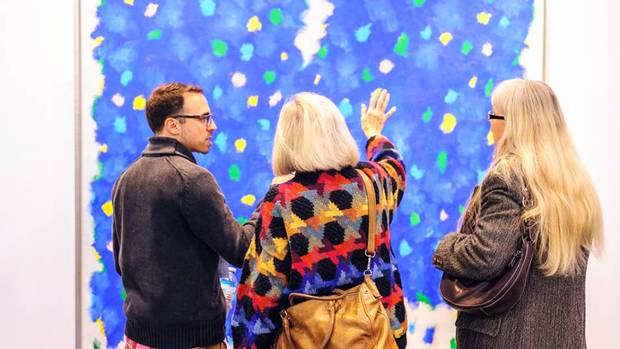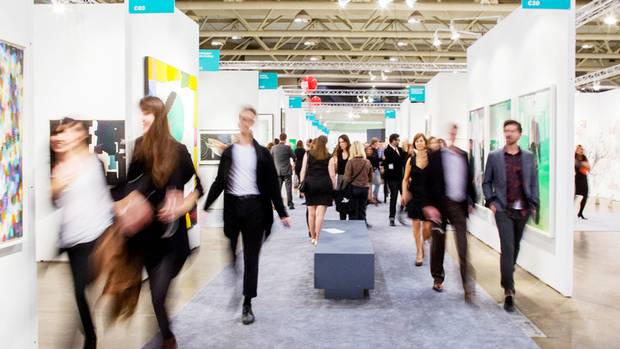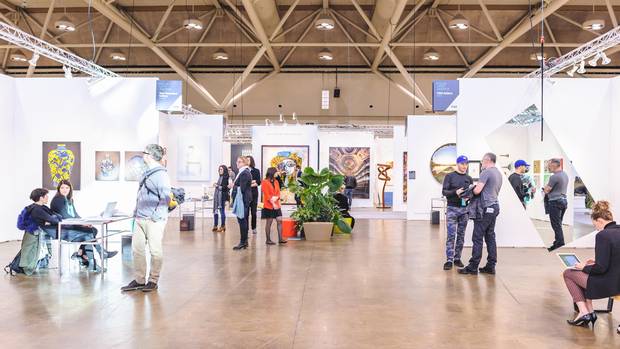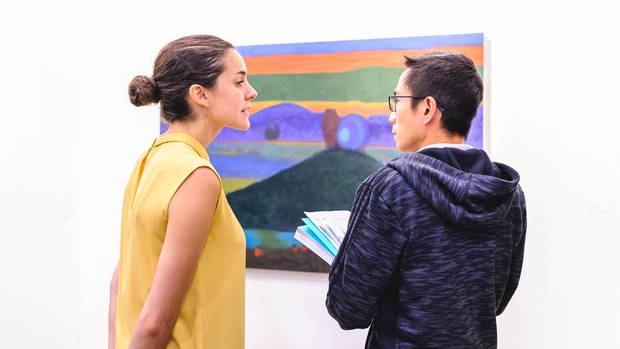Art Toronto still awaits its Tom Wolfe, and the way things are going it's likely going to wait forever. Because even though it's Canada's oldest and biggest international art fair and a bookmark happening in the fall cultural calendar – the 17th edition occurs this week – there's never really been that much to satirize. At least not viciously.
Some of the art is very pricey, it's true, the schmoozing intense, the off-site parties plentiful, the pretensions amusing, the affluenza present and accounted for.
But it's highly unlikely Art Toronto will ever be the cause of as much writerly bile as Art Basel Miami Beach famously was for Tom Wolfe in his 2012 novel, Back to Blood. There, you may recall, the Bonfire of the Vanities chronicler characterized the well-heeled who each December jet to Florida to buy the most contemporary contemporary art as "a mob of maggots" variously "squirming," "shoving" and "scurrying" in a display of "shallow and wanton waste."

The annual fair has been steadily growing since 2000.
Art Toronto
No such language, one can safely bet, will be used to describe the visitors and happenings at the Metro Toronto Convention Centre over the next few days. Since its inception in 2000 as the Toronto International Art Fair, the event has steadily grown without losing much civility. Indeed, this year, Art Toronto feels like it's pitching its biggest, most inclusive tent ever in terms of exhibitors (they total 124, about 10 per cent higher than in 2015) and programming.
As a result, expectations are high that attendance will surpass the record 21,000 established last year. Art sales, too, are expected to be buoyant. In each of the previous two years, the value was around $19-million.
For 2016, Susannah Rosenstock, named Art Toronto director by AT parent company Informa Exhibitions in late 2014, and her team have refreshed the fair with 28 new exhibitors. Over all, non-Canadians today represent about 45 per cent of the 111 exhibiting commercial galleries.

This year’s Art Toronto fair will feature 124 exhibitors, about 10 per cent higher, than in 2015, with expectations that attendance will surpass last year’s record 21,000.
Art Toronto
It's enough to prompt Rosenstock to proclaim the 2016 edition "our strongest list of galleries ever … in terms of the quality of the galleries, the quality of the work and the diversity of the galleries." Also: "We've worked really hard to make Toronto not this regional art fair but really an international art fair that people will not just notice here but [around the globe]."
One phenomenon that will be noticeable by its absence this year is the Feature Contemporary Art Fair. The creation of the Montreal-based non-profit Association des galeries d'art contemporain, it held two editions, one in 2014, the second in 2015, just east of AT, at Toronto's Canadian Opera Company building. In each case, Feature's run pretty much overlapped that of AT. However, Feature's focus was exclusively on Canadian contemporary art, with each of the fair's 20-plus vendors offering tightly curated presentations of work by no more than three artists at a time.
Feature's arrival on the fair scene was construed by some as a David-versus-Goliath scenario, and generally cheered as a sign of Toronto's cultural maturation. Yet even though Feature had more than 3,000 visitors and sales of just over $1-million, at least in 2014, these numbers apparently weren't sufficiently robust to encourage a longer commitment. In mid-March, 2016, organizers announced there would no third instalment.

Art Toronto is Canada’s oldest and biggest international art fair.
Art Toronto
Rosenstock didn't sound terribly surprised by the turn of events. "Building an art fair is not easy in any market," she said. "They're incredibly expensive and you need a ton of support from galleries, sponsors, partners and collectors. It takes a long time to build that." Rosenstock observed that "the collector base and art market here is strong and growing. But it's clearly not what it is in New York or London and other parts of the world. I don't know if there's enough to sustain two art fairs with a large Canadian component right now."
She added: "Fifty-thousand people fly to Miami for an art fair. Fifty-thousand people are only flying here for TIFF [the Toronto International Film Festival] right now. Until the market expands, there isn't necessarily a place for another fair."
In the meantime, Rosenstock and associates seem to be doing their darndest to make Art Toronto as much an "all-things-to-all-art-lovers" happening as possible. "Of course, the fair is commercial," she said. "The galleries are there to sell, to meet collectors and curators. But it's also an event, a place to bring the art community together whether those are museum directors, artists, students, art appreciators, cultural enthusiasts."

As ever, AT 2016 will be chock full of tours, lectures, panel discussions, conversations.
Art Toronto
Returning this year is AT's geographical focus program, keying, as it did last year, on contemporary art from Latin America. Sixteen galleries, from Argentina, Brazil, Chile, Mexico, Panama, Peru and Venezuela, will be exhibiting and selling their wares – last year, the Latin American contingent tallied eight exhibitors – while Venezuelan-born, New York-based curator Isabela Villanueva is highlighting a showcase of eclectic works by seven individual artists or collectives, including Cuba's Carlos Garaicoa, Mexico's Mario Navarro and Buro de Intervenciones Publicas from Guatemala.
"What we've noticed … is there has been a growing interest in North American galleries and South American galleries to participate in our fair here," Rosenstock said. "To work with Asia or Europe, obviously, these are much further away. And there's already a lot of fairs in Europe. It's more of a challenge for us to make headway [there] than it has been in the North American and South American market. It's where we can be sort of unique and make our mark.
"While we want to grow internationally," she continued, "we don't want it to be just a smaller version of the Armory [in New York] or Basel or [the Foire internationale d'art contemporain in Paris] placed in Toronto. We want to have our own identity and I think being strong in Canadian, American and South American galleries is a good place for us to be right now."

Art sales are expected to be buoyant. In each of the previous two years, the value was around $19-million.
Art Toronto
Brand-new to Art Toronto 2016 – brand-new, in fact, to Toronto, period – is the first Edition Toronto (aka 1/edition), a sort of free-admission companion mini-fair to AT, occurring on the convention centre's main floor. It's devoted to multiples of all sorts, artist-made books, ephemera, artist monographs, exhibition catalogues, small-run zines, collages and the like. More than 60 vendors are participating, some from as far away as Norway, Chile, Britain, Brooklyn, N.Y., and Oakland, Calif. "It's a way of introducing people to these other ways of collecting and owning and living with art work, to show that art doesn't have to be really expensive," says Bill Clarke, one of Edition Toronto's main organizers.
Clarke's also arranged what might just be Art Toronto's quirkiest exhibition/installation. This would be We Buy White Albums by New York's Rutherford Chang. For the past 10 years, Chang has been purchasing or otherwise acquiring first pressings of the Beatles' fabled self-titled double-album from 1968. You may recall the front and back of the dust jacket were blindingly white and blank – save for, on its cover, the embossed name of the Beatles and a stamped serial number.
Chang's We Buy White Albums consists of the 1,600 or so first-edition White Albums he's accumulated so far, racked as you would find them in a vinyl record store.
"By doing that numbering," Clarke explains, "designer Richard Hamilton was considering it as an artist's multiple, in a way, [albeit] a limited or numbered edition published in the millions." Chang's installation is "very much about this objectness of the record. It's also very much about how an originally very pristine, mass-produced artifact has aged over the course of almost 48 years and how previous owners personalized their copies."
As ever, AT 2016 will be chock full of tours, lectures, panel discussions, conversations. There's a "gallery hop" to 11 west-end galleries, plus party, on Friday evening. In addition, the fair's hosting seven artist projects, the most, I think, of any Art Toronto.
Likely drawing the most attention will be Canada's 2017 Venice Biennale laureate Geoffrey Farmer's one-off collaboration with Toronto's Life of a Craphead duo reimagining John Cage's 1959 sound sculpture/"score for solo television performance," Sounds of Venice. (The sole performance starts at 6 p.m. on Oct. 26.) Another expected big draw: Pit Couch, an all-blue installation/lounge area, with video and headphones, from Montreal's protean Jon Rafman, a three-time Sobey Art Award nominee.
Art Toronto 2016 begins Oct. 27 with limited-availability preview events in the Metro Toronto Convention Centre, 4:30 to 10 p.m. The fair is open to the general public each day at 12 p.m., Oct. 28 through Oct. 31 (arttoronto.ca).